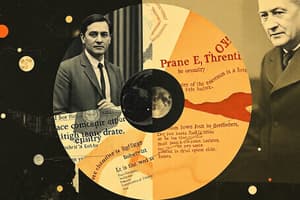Podcast
Questions and Answers
What are the primary types of microscopic particles that exhibit wave duality?
What are the primary types of microscopic particles that exhibit wave duality?
Electrons, protons, atoms, and molecules
What key feature of quantum mechanics does Bhor's theory of the hydrogen atom demonstrate?
What key feature of quantum mechanics does Bhor's theory of the hydrogen atom demonstrate?
- Uncertainty principle
- Superposition principle
- Quantization of energy (correct)
- Wave particle duality
Classical mechanics, as formulated by Isaac Newton, is sufficient to explain the behavior of microscopic particles.
Classical mechanics, as formulated by Isaac Newton, is sufficient to explain the behavior of microscopic particles.
False (B)
What is the relationship between wavelength and frequency of electromagnetic radiation?
What is the relationship between wavelength and frequency of electromagnetic radiation?
What is the defining characteristic of a black body in terms of radiation?
What is the defining characteristic of a black body in terms of radiation?
The intensity of black body radiation is independent of the temperature of the object.
The intensity of black body radiation is independent of the temperature of the object.
Which of the following best describes the distribution of energy in black body radiation?
Which of the following best describes the distribution of energy in black body radiation?
The peak wavelength of black body radiation shifts towards shorter wavelengths as temperature increases.
The peak wavelength of black body radiation shifts towards shorter wavelengths as temperature increases.
According to Wien's displacement law, what is the relationship between the peak wavelength of black body radiation and temperature?
According to Wien's displacement law, what is the relationship between the peak wavelength of black body radiation and temperature?
Who proposed the quantum theory of radiation, providing a theoretical basis for explaining the distribution of energy in black body radiation?
Who proposed the quantum theory of radiation, providing a theoretical basis for explaining the distribution of energy in black body radiation?
According to the quantum theory, the energy of electromagnetic radiation is continuous and can take any value.
According to the quantum theory, the energy of electromagnetic radiation is continuous and can take any value.
The photoelectric effect, where electrons are ejected from a metal surface when illuminated with light, can be fully explained by classical wave theory.
The photoelectric effect, where electrons are ejected from a metal surface when illuminated with light, can be fully explained by classical wave theory.
What is the term for the minimum frequency of light required to eject electrons from a metal surface in the photoelectric effect?
What is the term for the minimum frequency of light required to eject electrons from a metal surface in the photoelectric effect?
The kinetic energy of ejected electrons in the photoelectric effect is directly proportional to the intensity of the incident light.
The kinetic energy of ejected electrons in the photoelectric effect is directly proportional to the intensity of the incident light.
The Compton effect, where X-rays lose energy upon scattering from electrons, is a significant piece of evidence supporting the wave nature of light.
The Compton effect, where X-rays lose energy upon scattering from electrons, is a significant piece of evidence supporting the wave nature of light.
What is the name given to the change in wavelength of X-rays when they are scattered by electrons, as observed in the Compton effect?
What is the name given to the change in wavelength of X-rays when they are scattered by electrons, as observed in the Compton effect?
Who extended Bohr's model of the atom by incorporating the concept of elliptical electron orbits, helping to explain observed fine structure in atomic spectra?
Who extended Bohr's model of the atom by incorporating the concept of elliptical electron orbits, helping to explain observed fine structure in atomic spectra?
Bohr's atomic model could successfully explain the spectra of atoms with multiple electrons.
Bohr's atomic model could successfully explain the spectra of atoms with multiple electrons.
What is the primary reason for the limitations of Bohr's model when attempting to explain the spectra of multi-electron atoms?
What is the primary reason for the limitations of Bohr's model when attempting to explain the spectra of multi-electron atoms?
The concept of wave-particle duality, introduced by de Broglie, suggests that all moving material particles have associated wave properties.
The concept of wave-particle duality, introduced by de Broglie, suggests that all moving material particles have associated wave properties.
What is the equation that relates the wavelength of a matter wave to its momentum, known as the de Broglie relation?
What is the equation that relates the wavelength of a matter wave to its momentum, known as the de Broglie relation?
Heisenberg's uncertainty principle states that it is impossible to simultaneously determine both the position and momentum of a particle with absolute certainty.
Heisenberg's uncertainty principle states that it is impossible to simultaneously determine both the position and momentum of a particle with absolute certainty.
What is the mathematical relationship that expresses Heisenberg's uncertainty principle for position (Δx) and momentum (Δp)?
What is the mathematical relationship that expresses Heisenberg's uncertainty principle for position (Δx) and momentum (Δp)?
What is the primary implication of the uncertainty principle for the concept of electron orbits as described by Bohr's atomic model?
What is the primary implication of the uncertainty principle for the concept of electron orbits as described by Bohr's atomic model?
What is the quantum mechanical approach to understanding the location of an electron? What does 'ψ(x, t)' represent?
What is the quantum mechanical approach to understanding the location of an electron? What does 'ψ(x, t)' represent?
What is the term used in quantum mechanics to describe the allowed values of observable quantities, corresponding to specific wavefunctions, as obtained from the operator equation Aψ = aψ?
What is the term used in quantum mechanics to describe the allowed values of observable quantities, corresponding to specific wavefunctions, as obtained from the operator equation Aψ = aψ?
The time-dependent Schrödinger equation, which represents the evolution of a quantum mechanical system over time, can be considered the quantum mechanical analogue of Newton's Second Law of Motion.
The time-dependent Schrödinger equation, which represents the evolution of a quantum mechanical system over time, can be considered the quantum mechanical analogue of Newton's Second Law of Motion.
The concept of zero-point energy, a consequence of the uncertainty principle, implies that a harmonic oscillator, even in its ground state, possesses a minimum amount of energy.
The concept of zero-point energy, a consequence of the uncertainty principle, implies that a harmonic oscillator, even in its ground state, possesses a minimum amount of energy.
What is the 'Schrödinger equation'? What does it describe?
What is the 'Schrödinger equation'? What does it describe?
Flashcards
Quantum Chemistry
Quantum Chemistry
The study of matter at the atomic and molecular level, where classical mechanics fails and quantum mechanics takes over.
Wave-Particle Duality
Wave-Particle Duality
The phenomenon where microscopic particles exhibit both wave-like and particle-like properties, defying classical physics.
Quantization of Energy
Quantization of Energy
Energy can only exist in discrete packets, called quanta, rather than in continuous values.
Black Body Radiation
Black Body Radiation
Signup and view all the flashcards
Wien's Displacement Law
Wien's Displacement Law
Signup and view all the flashcards
Plank's Quantum Theory
Plank's Quantum Theory
Signup and view all the flashcards
Photoelectric Effect
Photoelectric Effect
Signup and view all the flashcards
Threshold Frequency
Threshold Frequency
Signup and view all the flashcards
Einstein's Photoelectric Equation
Einstein's Photoelectric Equation
Signup and view all the flashcards
Compton Effect
Compton Effect
Signup and view all the flashcards
Compton Shift
Compton Shift
Signup and view all the flashcards
Somerfield's Extension of Bohr Theory
Somerfield's Extension of Bohr Theory
Signup and view all the flashcards
Fine Structure
Fine Structure
Signup and view all the flashcards
de Broglie's Equation
de Broglie's Equation
Signup and view all the flashcards
Heisenberg's Uncertainty Principle
Heisenberg's Uncertainty Principle
Signup and view all the flashcards
Momentum and Position
Momentum and Position
Signup and view all the flashcards
Zero-Point Energy
Zero-Point Energy
Signup and view all the flashcards
Schrödinger's Wave Equation
Schrödinger's Wave Equation
Signup and view all the flashcards
Wave Function (ψ)
Wave Function (ψ)
Signup and view all the flashcards
Eigenvalue
Eigenvalue
Signup and view all the flashcards
Expectation Value
Expectation Value
Signup and view all the flashcards
Probability Density
Probability Density
Signup and view all the flashcards
Electron Density
Electron Density
Signup and view all the flashcards
Conservation Laws
Conservation Laws
Signup and view all the flashcards
Newton's Laws of Motion
Newton's Laws of Motion
Signup and view all the flashcards
Time-Dependent Schrödinger Equation
Time-Dependent Schrödinger Equation
Signup and view all the flashcards
Study Notes
Quantum Chemistry - Lecture Notes
- Quantum chemistry is a branch of chemistry that studies the structure and properties of molecules using the principles of quantum mechanics.
- Classical mechanics describes the motion of macroscopic objects, while quantum mechanics describes the behavior of microscopic particles like electrons, protons, atoms, and molecules.
- Microscopic particles exhibit wave-particle duality, meaning they possess properties of both waves and particles.
- Radiation is typically classified as an electromagnetic wave characterized by its wavelength (λ) and frequency (v).
- The velocity of radiation (c) is related to wavelength and frequency by the equation: c = λv.
- Black body radiation is the electromagnetic radiation emitted by an object at a given temperature.
- The distribution of energy in black body radiation is not confined to a single wavelength but spreads over a wide spectrum of wavelengths.
- The energy density of black body radiation depends on the temperature and the wavelength.
- Classical physics failed to explain the distribution of energy in black body radiation.
- Planck proposed that energy is quantized, emitted or absorbed in discrete packets called quanta.
- Quantum theory revolutionized the understanding of black body radiation, explaining the experimental observations by the concept of quantization.
- The energy of a quantum is directly proportional to its frequency, described as E = hv, where h is Planck's constant.
- Einstein's photoelectric effect demonstrated the particle nature of light and the quantization of energy, leading to a deeper understanding of electromagnetic radiation, further supporting the concept of quantized energy.
- Compton effect proved further evidence of the particle nature of light, showing that photons transfer momentum to electrons during collision.
- Bohr's theory, while successful in explaining the hydrogen atom's spectra, failed to explain the spectra of multi-electron atoms and ions.
- Heisenberg's uncertainty principle states that it is impossible to simultaneously determine both the momentum and position of a particle with perfect accuracy.
- De Broglie introduced the concept of matter waves, suggesting that all matter exhibits wave-like properties, connecting the wave and particle nature of matter.
- Schrödinger's equation is a fundamental equation in quantum mechanics, providing a mathematical framework for solving physical problems involving matter and its interactions with quantum-based radiation.
- Zero point energy is the minimum energy a quantum harmonic oscillator can have, arising from the wave-like properties of matter, even at its ground state.
- Quantum mechanics describes the behavior of particles at the atomic and subatomic levels using complex wave functions and operators, leading to a probabilistic description rather than the deterministic picture of classical mechanics.
Studying That Suits You
Use AI to generate personalized quizzes and flashcards to suit your learning preferences.




